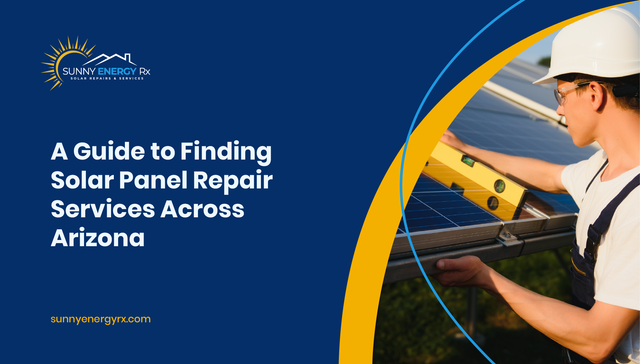Arizona Solar Panel Repair: From First Signs to the Right Fix
This blog was originally published on Sunny Energy RX.
Arizona’s sunshine powers your savings, but the same heat, dust, and monsoon grit can nudge a healthy system off course. If your monitoring app shows a slump on clear days or your inverter light isn’t a calm, steady green, treat it like a check-engine light. A little attention now prevents bigger bills later. This guide explains what to watch for, what you can safely do from the ground, and how to choose a repair team that gets it right the first time.
How to Spot Trouble (Without Climbing a Ladder)
Most problems announce themselves quietly: a week of perfect weather with lower-than-usual output, a new warning icon on the inverter, or a battery that never seems to top off. From the ground, scan the array for anything that looks off, such as misaligned panels, trapped debris, or signs of bird activity. You don’t need to touch a thing; you’re simply trying to confirm that the performance dip isn’t just a cloudy day you forgot about.
- Unexplained production drops across several sunny days
- Inverter lights turning red/amber or recurring error codes
- Frequent shut-offs/restarts (cycling) during hot afternoons
- Visible issues: cracked glass, sagging conduit, chewed wiring, or brown hot-spot marks
If any of these show up, move to simple, safe checks and call a pro if the symptoms persist.
Safe Checks You Can Do Right Now
Think of this as a homeowner’s triage: no tools, no ladders, no opening equipment. Start by rebooting exactly as your manual describes (usually AC off, then DC; reverse to power back up). Verify no breakers or external disconnects are tripped. Make sure your monitoring device is online since Wi-Fi hiccups often masquerade as no production. Clear boxes or stored items that might block airflow around the inverter, but don’t open the casing. Finally, take photos of any error lights or messages and jot down the date, temperature, and whether a dust storm rolled through recently. That context helps a technician diagnose in minutes, not hours.
When to Call a Professional Immediately
Some signals aren’t worth waiting on. A burning-plastic smell, visible scorch marks, loud arcing or buzzing, repeatedly tripping breakers, or obvious storm damage all warrant a professional visit right away. Solar is an electrical system on your roof; the safe move is to step back and bring in someone trained to work on it.
Picking the Right Repair Partner in Arizona
Repairs in the desert are different. You want a service-first crew that understands heat management, dust mitigation, and post-monsoon checkups. Ask for licensing and insurance, and confirm experience with your panel and inverter brands. Good shops lead with diagnostics, share an itemized estimate before work begins, and provide photos plus a clear repair-vs-replace recommendation. If a major component is aging and the repair approaches half the cost of a new unit, a replacement often makes better long-term sense, especially in high-heat installations.
A solid repair visit should include:
- Targeted diagnostics (read inverter logs/codes, test strings/modules, confirm communications)
- Safety and integrity review (racking, roof penetrations, wiring, grounding)
- Performance verification (expected vs. actual output)
- A written plan with pricing, parts details, and warranties
- Documentation you can keep for records and future claims
Prevent Repeat Breakdowns (Desert-Smart Habits)
Think prevention, not reaction. Keep the inverter’s surroundings clear so it can shed heat, and avoid storing items that trap hot air. After dust storms or hail, glance at your monitoring app and do a ground-level scan for anything new. Book periodic inspections and safe cleanings to remove baked-on grime and catch loosening hardware before it becomes a leak or a fault. If birds love your roofline, ask about guards to keep them from nesting under the array.
Your Simple Next Steps
- Document: Capture photos of lights/codes and anything unusual you can see from the ground.
- Diagnose: Call a service-focused Arizona repair team and request diagnostics first.
- Decide: Review a clear repair-vs-replace plan with itemized costs and timing, then verify the fix in your monitoring app.
Ready to Get Your System Back to Peak?
Call to action: Seeing warning lights, persistent production dips, or signs of damage? Schedule a professional solar repair with Sunny Energy RX. We’ll diagnose quickly, fix safely, and set a prevention plan tailored to Arizona’s climate so your system gets back to peak and stays there.
Don’t let the desert dim your savings book your Sunny Energy RX repair today.
